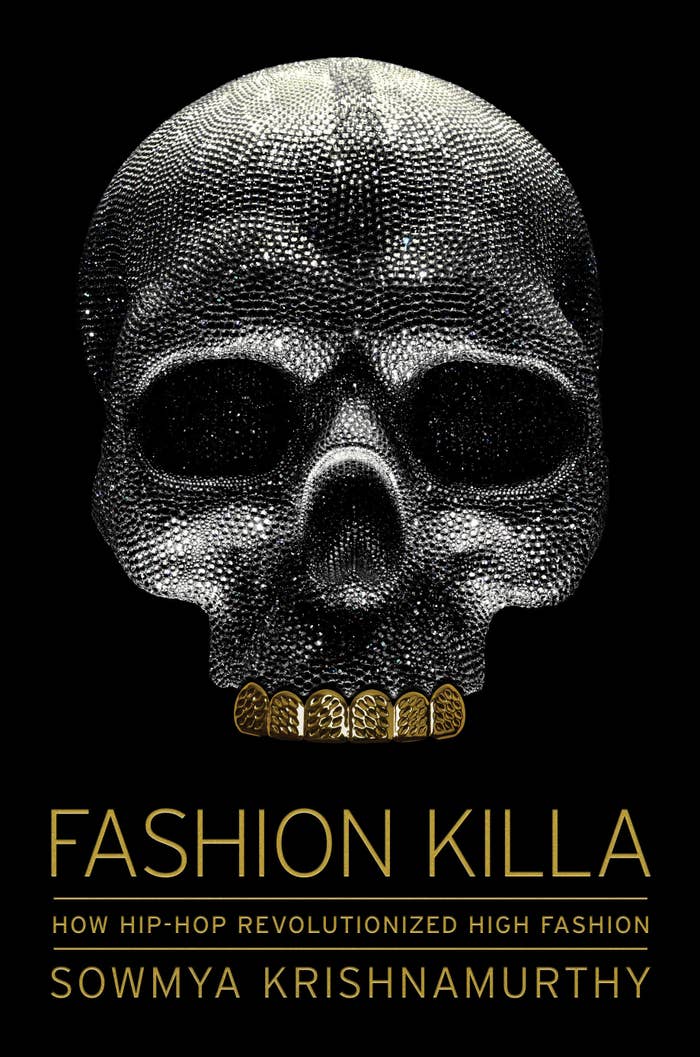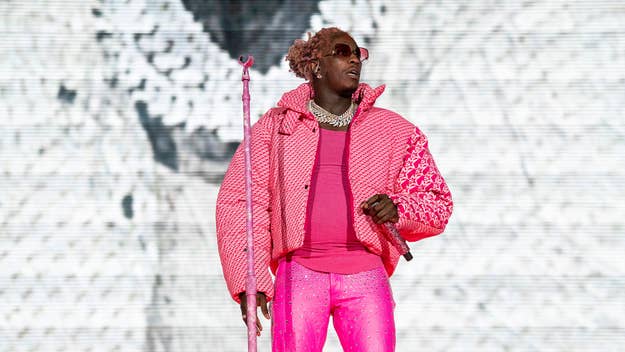
High fashion has much to thank hip-hop for, and Sowmya Krishnamurthy's new book, Fashion Killa: How Hip-Hop Revolutionized High Fashion, breaks down how the genre pushed premium style forward. The book explores how the last fifty years of fashion and hip-hop have been so heavily intertwined. Featuring interviews with rappers, designers, stylists, and more, the book details how icons such as Diddy, Virgil Abloh, Lil Kim, and various fashion houses evolved alongside one another.
In an excerpt exclusively provided to Complex, which can be read below, Young Thug and his gender-challenging fashion are given the highlight. Of particular note is his cover for the 2016 project Jeffrey, in which he sported an Alessandro Trincone-designed dress.
Purchase Krishnamurthy's Fashion Killa here via Simon & Schuster, and read an excerpt from chapter 15 below.

Young Thug extended his long limbs to exaggerate the fluidity of the fabric. Baby blue with rows and rows of soft ruffles. At six foot three, the rapper had the proportions of a model, but his heavily inked-up face that included a snake by his hairline and rain cloud below his lower lip would give designers pause (possibly except for Louis Vuitton, given the huge “LV” tattooed on his neck). The garment was a modern take on the Japanese samurai warrior with a reimagined kosode cloak and jingasa hat that opened up into a full warrior stance. Young Thug wore the dress by Alessandro Trincone on the cover of his 2016 mixtape, Jeffrey. It was something only the self-proclaimed thug could pull off. “In my world, you could be a gangsta with a dress or you could be a gangsta with baggy pants,” he said. “I feel like there’s no such thing as gender.”
The rapper first encountered the dress during V Magazine’s VFILES Season 7. The runway show championed young talent during New York Fashion Week and Thug was a mentor alongside legendary supermodel Naomi Campbell, makeup artist Pat McGrath, Fear of God’s Jerry Lorenzo, and stylist Mel Ottenberg. He was hands-on, literally, walking on the runway to fix a model’s look. “I think he is going to have a major impact on the way fashion and music come together in the future as he looks through a lens that is totally unfiltered and not subjected to preexisting paradigms of how one should approach the way they dress,” VFILES founder Julie Anne Quay said. “His approach to gender fluidity is a very powerful moment I think for fashion because it is connected to his approach to music and the message he shares through that medium.”
“This is the cover for my album Jeffrey,” Thug said when he first saw the dress, likening it to a character from a popular action-adventure video game. “It’s like Mortal Kombat . . . Sub-Zero.” Wearing a piece of art was an involved process. Garfield Larmond, the photographer behind the cover of Jeffrey, said, “When we got on set, it definitely took like an hour and a half to put it on. Then once he put it on, and I started shooting, they noticed a piece was off—like something really intricate. So we had to take another thirty minutes to pin stuff up, get the hat right. It took hours. Hours on top of hours.” For the twenty-five-year-old Italian designer of the dress, the widespread notoriety was a total surprise. Trincone explained: “I was literally shocked because Young Thug and me—I don’t know. But I said, ‘Okay, let’s try it.’ Then when I saw the cover I was like ‘Oh my God. I did it.’ I liked it.”
Young Thug’s background was in sharp contrast to his carefree fashion persona. Born Jeffrey Williams on August 16, 1991, he was raised in the Jonesboro South housing project in Atlanta. “It was worse than struggle—that shit was hell,” he said. Growing up poor, he was one of eleven children, and got in trouble from a young age. “I was in the streets at eight, nine years old,” he told Rolling Stone. “I was going to school so my dad and mom would keep buying me clothes, but when I got out I did what I wanted to do—fighting, all kinds of shit.” In middle school, he was sent to juvenile detention after breaking his teacher’s arm. “I didn’t do it for people to understand me. I did it for the weird ones,” he told XXL about his desire to rap. He released his first mixtape, I Came from Nothing, in 2011 and quickly amassed an expansive discography, including 2015’s Barter 6, which went gold. His music was vibrant and fun with weird ad-libs and twisty lyrics—which an actual linguist decoded for Genius—and he became the leader of modern trap. His first chart-topper on the Billboard Hot 100 was his feature on Camila Cabello’s “Havana” in 2018—and he sounded even sexier than she did. Young Thug was an anomaly, to say the least, as a flamboyant street rapper who intentionally subverted gender norms. “Ninety percent of my clothes are women’s,” he told GQ. “Because women’s clothes are [slimmer] than men’s clothes. The jeans I got on right now, they’re women’s jeans. But they fit how they’re supposed to fit. Like a rock star.”
High fashion heralded the enfant terrible as an androgynous revolutionary. Dazed called him “the closest music style icon we have to [David] Bowie.” Vogue spotlighted him for his femme style. He named his cohort and record label Young Slime Life or YSL (a nod to the French house formerly known as Yves Saint Laurent) and appeared in a campaign for Calvin Klein, wearing womenswear. “You look hot in a dress,” said a woman in his promo shoot for Calvin Klein. Without a blink, he responded, “Thanks.”
However, pushing gender boundaries in clothing didn’t immediately translate in hip-hop. Instead of its being the precursor to progressiveness, questions abounded about Young Thug’s sexuality and gender identity, despite the fact that he was very publicly romantically involved with women. Reddit forums flooded with rumors and heated fan discussions on topics like “Young Thug, gay or not?,” “Since when is he gender fluid???,” and “Is young thug a part of the LGBT community?” Internet detectives scoured his old tweets and lyrics in search of a smoking gun about his preferences for men, women, or both. “He’s a hip-hop cross-dresser,” said radio shock jock Charlamagne Tha God, pointing to parallels with Prince, rock artists, and hip-hop artist CeeLo Green, who wore a wedding dress for a 2008 photoshoot with his group Gnarls Barkley. The latter was more of a publicity stunt than a genuine fashion statement, so perhaps Young Thug also intended to cause commotion. “I think he’s part of the new generation of men who have been growing up under the feminization of society . . . It’s a lot of men who didn’t have fathers in the house. They just have de-masculated men in a way,” mused Charlamagne. “But the other side of the coin is, he may be one of those guys who dresses that way, but he’s very much a man. We don’t know. I don’t know the dude. Or maybe it’s just the character.”
Excerpted from Sowmya Krishnamurthy’s FASHION KILLA: How Hip-Hop Revolutionized High Fashion, published by Gallery Books, a subsidiary of Simon & Schuster.

